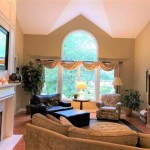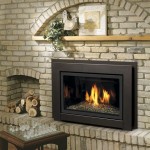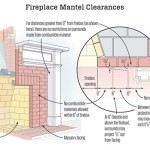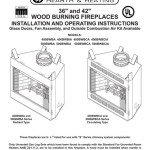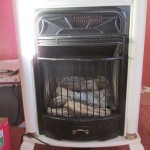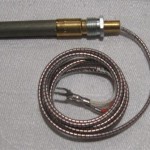Fireplace Combustion Air Vent: Enhancing Efficiency and Safety
A fireplace combustion air vent, also known as an outside air kit, is a crucial component for modern fireplaces, particularly those designed to operate efficiently and safely in well-insulated homes. This vent provides a dedicated source of fresh air for the combustion process, mitigating negative pressure within the house and enhancing overall fireplace performance. The absence of such a vent can lead to a variety of issues, ranging from inefficient burning to potential safety hazards.
In older homes, natural air infiltration often provided sufficient air for combustion. However, modern construction practices prioritize energy efficiency, resulting in tighter building envelopes. This reduces air leakage, which in turn limits the availability of air for appliances that consume oxygen, such as fireplaces, wood stoves, and even some gas furnaces. Without a dedicated combustion air source, these appliances must draw air from within the home, creating negative pressure.
Negative pressure occurs when the air pressure inside a building is lower than the air pressure outside. This pressure differential can cause various problems. One significant problem is backdrafting, where exhaust gases from the fireplace or other combustion appliances are drawn back into the house instead of venting properly up the chimney. This can introduce dangerous carbon monoxide into the living space, a serious health hazard.
Beyond safety concerns, a combustion air vent also improves the efficiency of the fireplace. When a fireplace draws air from inside the house, it's effectively pulling already heated air outside. This necessitates the heating system to work harder to maintain the desired temperature, leading to increased energy consumption and higher heating bills. By supplying outside air directly to the fire, the fireplace doesn't deplete the heated air within the home, resulting in a more efficient burning process.
Understanding the function and necessity of a fireplace combustion air vent is therefore essential for homeowners who want to enjoy the ambiance and warmth of a fireplace safely and efficiently. The installation and maintenance of these vents, however, require careful consideration and often professional expertise.
Understanding the Benefits of a Combustion Air Vent
The primary benefit of a combustion air vent is the mitigation of negative pressure within the home. This directly addresses the risk of backdrafting, ensuring that flue gases are properly exhausted through the chimney. By supplying an external source of air for combustion, the fireplace avoids competing with other appliances or the home's ventilation system for air. This is particularly important in airtight homes where the natural exchange of air is significantly reduced.
Furthermore, a combustion air vent enhances the efficiency of the fireplace by preventing the consumption of heated indoor air. When a fireplace draws air from inside the house, it creates a vacuum that needs to be filled. This vacuum is often filled by drawing cold air in through cracks around doors and windows, or even through the chimney of other appliances. The heating system then has to work harder to compensate for this influx of cold air. By using a dedicated outside air source, the fireplace avoids this energy-wasting process.
Another less obvious benefit is improved combustion quality. When the fireplace has a consistent and adequate supply of air, the fuel burns more completely. This results in less smoke, creosote buildup in the chimney, and potentially higher heat output. Incomplete combustion, on the other hand, produces more pollutants and reduces the overall efficiency of the burning process. A combustion air vent ensures that the fire receives the oxygen it needs to burn cleanly and efficiently.
Finally, the use of combustion air vents can often improve the lifespan and reliability of the fireplace components, as a cleaner and more effective combustion process reduces wear and tear on the firebox and chimney.
Types of Fireplace Combustion Air Vents
Several different types of fireplace combustion air vents are available, each with its own advantages and disadvantages. The most common type is a simple pipe that runs from the outside of the house to the fireplace firebox. This pipe is typically equipped with a damper that can be opened or closed to control the airflow. Some models also include a screen to prevent debris and insects from entering the vent.
Another type of combustion air vent is designed to be installed directly into the fireplace's ash dump. This type of vent is particularly useful for fireplaces that do not have a dedicated knockout for an outside air kit. The air is drawn in through the ash dump opening and directed into the firebox.
More sophisticated combustion air vent systems may include a fan to actively draw air into the fireplace. These systems are often used in homes with very tight building envelopes where passive ventilation is insufficient. The fan can be controlled manually or automatically, depending on the model.
The selection of the appropriate type of combustion air vent depends on several factors, including the design of the fireplace, the construction of the house, and the homeowner's preferences. It's recommended to consult with a qualified fireplace professional to determine the best option for a particular situation.
Furthermore, the placement of the vent's exterior termination point is crucial. It should be located in an area that is free from obstructions and away from potential sources of contamination, such as dryer vents or exhaust fans. The vent should also be positioned to prevent snow or rain from entering the system. A hooded vent is generally recommended to protect the opening from the elements.
Installation and Maintenance of Combustion Air Vents
The installation of a fireplace combustion air vent typically involves cutting a hole in the exterior wall of the house and running a pipe to the fireplace. This process can be relatively straightforward for experienced DIYers, but it's generally recommended to hire a qualified professional to ensure that the vent is installed correctly and safely.
The installation process also includes connecting the vent to the fireplace firebox. Many modern fireplaces are equipped with a knockout specifically designed for this purpose. If the fireplace does not have a knockout, the vent may need to be connected to the ash dump or another suitable opening. It is crucial not to compromise the firebox itself during this process. Many fireboxes are lined with firebrick, which is there to protect the metal of the firebox from the high temperatures of the fire. Altering this in any way could cause structural damage.
Once the vent is installed, it's important to maintain it properly to ensure optimal performance. This includes regularly inspecting the vent for obstructions, such as debris or insects. The damper should also be checked periodically to ensure that it is functioning correctly. If the vent is equipped with a fan, the fan should be cleaned and lubricated as needed.
Another important aspect of maintenance is ensuring that the vent is properly sealed to prevent air leaks. Any gaps or cracks around the vent should be sealed with caulk or other suitable sealant. This will help to prevent cold air from entering the house during the winter months and warm air from escaping during the summer months.
Regular chimney inspections and cleanings are also essential for maintaining the overall safety and efficiency of the fireplace. A clogged chimney can impede the flow of flue gases, increasing the risk of backdrafting and carbon monoxide poisoning. A qualified chimney sweep can inspect the chimney for creosote buildup, cracks, and other potential problems.
In conclusion, a properly installed and maintained fireplace combustion air vent is a valuable investment for any homeowner who wants to enjoy the benefits of a fireplace safely and efficiently. It addresses the risks associated with negative pressure, improves combustion quality, and reduces energy consumption. While installation and maintenance may require some effort, the long-term benefits far outweigh the costs.

Fireplaces And Wood Stoves Have Proper Ventilation Building America Solution Center

Air A Lator Fresh Intake Devices Bernard Dalsin Manufacturing

Outside Air Kits How They Help Your Fireplace Venting

Fireplace Cover To Keep Cold Air Out

Vented Vs B Vent Direct Free Dixie S

What Are The Best Ways To Vent A Gas Fireplace Zoroast
.aspx?strip=all)
Benefits Of Direct Vent Fireplaces Regency Fireplace S

Draft Coming Through The Fireplace Vent Cleverly Solved

How To Use The Vents Control A Wood Burning Stove
Is There A Way To Provide Fresh Air Intake From The Outside For Typical Brick Residential Fireplace On An Exterior Wall Quora
Related Posts

